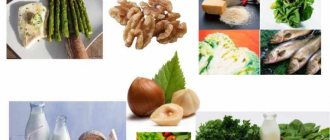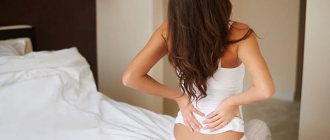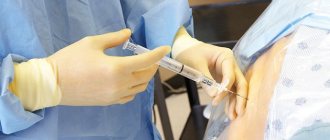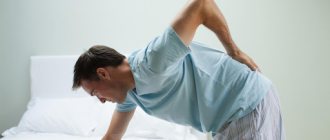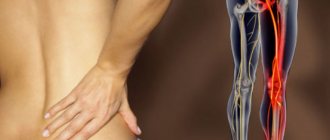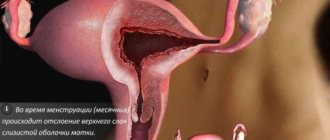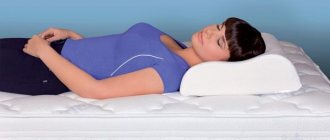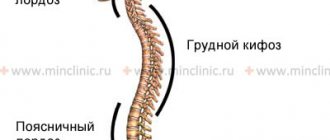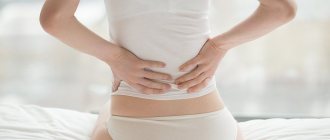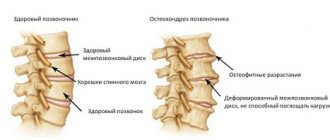Author of the article: Anastasia Yurchenko - medical copywriter Verified by: Eduard Svitich - orthopedic traumatologist
High physical activity and carrying heavy loads are always a test for the human musculoskeletal system. After such work, pain in the back and lower back often occurs. These symptoms may last for several days or even weeks. You shouldn’t let your health take its course and hope that it will “go away on its own.” In such situations, it is necessary to provide support to the lower back, relieve pain and speed up the recovery process, since in the future acute pain may become chronic and it will become much more difficult to deal with it.
General information
The lower back is an area that experiences significant stress due to being in an upright position. The spinal column is represented by five large vertebrae, which are additionally strengthened by a muscular frame. 9 out of 10 cases of pain in this area are provoked by pathology of the musculoskeletal system: osteochondrosis, muscle spasm, herniated disc, pinched nerve root.
The remaining 10% of cases are associated with diseases of internal organs located in the lumbar projection: kidneys, genitourinary system, intestines, liver. Even a doctor during an examination cannot always accurately determine the cause of pain, which is why this condition requires careful laboratory and instrumental diagnostics.
Types of pain
The first thing the doctor asks about is the nature of the sensations. Depending on the cause that caused it, lower back pain can be:
- acute: usually occurs abruptly and is characterized by high intensity; the duration of sensations is no more than 1.5 months;
- subacute: lasts 6-12 weeks;
- chronic: sensations of any intensity, lasting 12 weeks or more;
- transient (variable): appears periodically;
- aching;
- dull;
- strong, medium intensity, weak.
This division is conditional. Depending on the situation and circumstances, the nature and duration of sensations may vary. It is important to describe them to the doctor as fully as possible.
Make an appointment
Lumbar bandage against back pain
Bandage and corset products are always relevant in cases where discomfort occurs in the spine. Unpleasant sensations can manifest themselves at any time: when playing sports, lifting weights, simply when staying in a stationary position for many hours (for example, in an office), among drivers, pregnant women, elderly people, and so on on the list. Lower back pain is the most common complaint with which patients consult doctors. In this case, experts recommend immediately buying a lower back bandage. For what?
- Spinal stabilization;
- Compression effect on tissue;
- Relieving tension from the lower back;
- Even distribution of the load on the back;
- Prevention of complications and exacerbations of chronic diseases.
Causes
There are many reasons why your back begins to hurt in the lumbar region. Most often, provoking factors are:
- hypothermia;
- lifting weights;
- uneven distribution of load (due to pregnancy, postural disorders, pathology of the musculoskeletal system);
- infectious lesion;
- diseases of the musculoskeletal system;
- inflammatory processes, including autoimmune;
- prolonged stay in an uncomfortable position;
- changes in the composition of bone tissue (osteoporosis);
- volumetric processes: benign and malignant tumors, abscesses;
- hormonal changes (menstruation, pregnancy, menopause);
- kidney diseases (urolithiasis, pyelonephritis, glomerulonephritis, abscesses);
- pathology of the gastrointestinal tract;
- diseases of the uterus and appendages in women, prostate diseases in men, etc.
Lower back pain after lifting weights: causes
If your lower back hurts after lifting weights, you should be concerned about this condition and do not ignore it, since you could have suffered a serious injury. Developing or chronic diseases can manifest themselves in the same way.
Injury
Pain in the lower back after lifting heavy objects indicates that an injury has occurred. In this case, it is important not to delay visiting a neurologist.
to determine exactly how severe the injury is, its possible consequences, and to provide effective treatment in a timely manner. If you seek medical help in a timely manner, treatment often consists of creating rest, applying ointments and bandages.
Muscle strain or strain
Traumatic injuries, when you lift too heavy a load abruptly, can be called differently - “broke your back”, after which you have to think about why your lower back hurts when lifting heavy objects. This means that in the process of physical work a certain group of muscles was damaged, since an exorbitant load was placed on them. The pain can be severe and sharp if the sprain is serious, and moderate if the injury is not severe. It can last from a few minutes to several weeks, disrupting a person’s normal lifestyle and weakening a person’s ability to work.
Osteochondrosis
In the presence of osteochondrosis, lower back pain often appears after lifting heavy objects. This disease is characterized by thinning of the cartilage tissue from which the intervertebral discs are formed. Due to this, the spinal column partially loses its shock-absorbing ability, and therefore can withstand much less load.
Radiculitis
If your lower back hurts after lifting weights, what to do largely depends on what caused the development of acute pain. The problem may be radiculitis, which is a pathology of the nerve roots of the spinal cord. This condition requires treatment.
Intervertebral hernia
Sharp pain in the lower back when lifting weights may be a consequence of protrusion of nerve tissue, which occurs due to the fact that the integrity of the intervertebral disc is damaged. The intensity of the pain depends on how large the hernial protrusion is. Often pain occurs precisely when lifting weights, since the protrusion appears at the moment of heavy load.
Kidney pain
Often the reason for this condition, in which both men and women experience lower back pain after lifting heavy objects, lies in kidney disease. It could be pyelonephritis
or kidney stones that manifest themselves after exercise.
Tuberculosis of bones
The disease is quite rare, accounting for about 3.5% of the total number of tuberculosis cases. It requires urgent treatment for lower back pain after lifting heavy objects. Bone tuberculosis leads to tissue destruction and serious disturbances in the functioning of the musculoskeletal system. If the pain in the lumbar region after lifting weights is insignificant, the disease is most likely still in its early stages.
Diseases
Lower back pain can be a symptom of various diseases of the musculoskeletal system and internal organs. The main task of the doctor is to find out what exactly caused the deterioration of the condition and take the necessary measures.
Here are the most common pathologies.
Ankylosing spondylitis (ankylosing spondylitis)
This is a systemic inflammatory disease in which individual vertebrae fuse into a single conglomerate. At the same time, calcium is deposited in the ligaments that stabilize the spine, causing the affected area to almost completely lose mobility.
Distinctive features of low back pain due to ankylosing spondylitis include:
- an increase in intensity at rest, especially with prolonged exposure to a horizontal position;
- stiffness of movements in the lumbar region;
Osteochondrosis of the lumbar spine
This is a very common disease in which the intervertebral discs, which act as shock absorbers, become thinner. The result is irritation of the nerve roots and spasms of the surrounding muscles, causing severe pain. At a late stage of the disease, a herniated disc forms, which can put pressure on the spinal cord, increasing pain.
With osteochondrosis, the pain intensifies:
- when rising from a sitting or horizontal position;
- when trying to lie on your stomach;
- when bending over.
If the disease has caused the formation of a massive hernia, pain in the lower back is often accompanied by numbness and or weakness of one or both legs.
Curvature of the spine in the lumbar region (kyphosis, scoliosis)
Pain in this pathology occurs in the middle and late stages of the disease. Discomfort usually occurs towards the end of the day and is often accompanied by fatigue of the back muscles. The pain is most often caused by spasm of the spinal muscles, and spasm of muscles at a distance (gluteal, periarticular muscles of the upper and lower extremities) is also possible.
Spondyloarthrosis
This is a degenerative-dystrophic disease of the cartilage tissue covering the intervertebral discs. It gradually becomes thinner and destroyed, and bone growths (osteophytes) appear around the affected area. As a result of the reduction in the distance between the vertebrae, the spinal canal narrows, irritation of the nerve roots and spinal cord occurs.
Pain with this pathology:
- intensifies after exercise (prolonged standing, walking) and goes away after rest;
- accompanied by stiffness of movement, first in the morning, then constant;
- can radiate to the thigh and hip joint area.
The muscles in the affected area spasm and are constantly in tension, which also increases pain.
Urolithiasis disease
An attack of urolithiasis is characterized by severe lumbar pain from the affected kidney. At the same time, the sensations do not change depending on the posture; a person cannot find a position in which they weaken even a little. The attack is often accompanied by a decrease in the amount of urine and a change in its color to reddish.
Lower back pain can also be a consequence of:
- algomenorrhea (painful periods);
- pregnancy;
- inflammation of the pancreas;
- osteomyelitis;
- intestinal obstruction;
- appendicitis, etc.
Causes of spinal diseases
In addition to genetic predisposition, many factors lead to spinal diseases. Pain in the lower back can be caused by:
- jerk weight lifting;
- Frequently carrying heavy objects in one hand or on one shoulder;
- repeated microtraumas during hard work or sports;
- hypothermia;
- obesity (causes increased stress on the spinal column);
- poor nutrition;
- dehydration;
- infectious diseases;
- physical inactivity.
With weak motor activity, blood circulation is disrupted, muscles and ligaments weaken, tissue nutrition deteriorates, intervertebral discs gradually become thinner, and vertebrae become displaced. Important elements for the prevention of spinal pathologies are daily exercises and walks, which give the muscles the necessary load.
Pain due to arthrosis and osteochondrosis The most common reason that the lower back hurts after lifting weights is osteochondrosis. With this degenerative-dystrophic disease, cartilage becomes thinner, nerve roots and blood vessels suffer. Arthrosis gives a similar clinical picture, but with it the cartilage tissue is replaced by bone growths - osteophytes. Because of them, the spine becomes “ossified” and loses mobility. Without treatment, these pathologies lead to:
- increasing pain;
- decreased sensitivity of the limbs;
- deterioration of mobility;
- development of complications, including constipation, impotence, enuresis;
- spinal cord injuries, paralysis.
Please note: diseases of the spine show almost no symptoms for a long time. At first, the lower back hurts after lifting heavy objects or walking for a long time. Then there is pain in the lower back when bending forward and turning. Gradually, the pain becomes constant and intensifies from almost any irritant. Lower back pain can occur even when just taking a deep breath. Also, arthrosis and osteochondrosis are characterized by the appearance of crunching and clicking sounds when moving and a gradual decrease in motor function.
Pain in various parts of the back
The location of pain can tell a lot about its cause. Pain in the upper lumbar region may be due to:
- diseases of the spine;
- injuries;
- muscle spasms due to their overstrain;
- cardiovascular diseases;
- tumors;
- diseases of the gastrointestinal tract.
If the epicenter is in the lower back, the list of probable causes includes, in addition to spinal diseases:
- kidney pathology (pyelonephritis, urolithiasis);
- intestinal dysfunction (constipation, flatulence);
- spasms or inflammation in the pelvic organs (salpingo-oophoritis, endometritis);
- physiological reasons, in particular pregnancy;
- pinched sciatic nerve.
A shift of pain to the right or left may indicate damage to the corresponding spinal cord root or kidney.
Lower back pain
Arthritis
Pyelonephritis
Cervical cancer
Menopause
5275 April 24
IMPORTANT!
The information in this section cannot be used for self-diagnosis and self-treatment.
In case of pain or other exacerbation of the disease, diagnostic tests should be prescribed only by the attending physician. To make a diagnosis and properly prescribe treatment, you should contact your doctor. Lower back pain - causes of occurrence, what diseases it occurs with, diagnosis and treatment methods.
Almost everyone experiences lower back pain, especially after 40 years of age. One of the reasons is osteochondrosis - a degenerative-dystrophic change in the spine. However, in many cases it does not explain the nature, severity and duration of back pain.
Types of pain
Back pain can be a symptom of a serious illness, but for the vast majority the pain is benign. One of the main points that should be taken into account when diagnosing back pain, and in particular in the lower back, is its duration. In most cases, muscle pain can last up to two weeks and then disappear. Pain caused by organic changes in the spine (intervertebral hernia, arthrosis) lasts much longer and can radiate to the leg, perineum, and be accompanied by a feeling of numbness, burning, and goosebumps.
Pain caused by cardiovascular diseases and diseases of the abdominal organs is characterized by greater intensity and duration.
Possible reasons
Pain caused by spinal disease or injury
In most cases, back pain is caused by dysfunction of the intervertebral joints.
A decrease in the distance between the vertebrae due to degenerative changes in the intervertebral discs leads to increased friction of the articular surfaces. This can cause subluxation and joint locking. The muscles surrounding the affected joint are in a state of overstrain for a long time, which increases joint pain.
Most often, pain in diseases of the spine is dull in nature, that is, its intensity increases gradually, intensifying with movement and weakening at rest. .
In cases of severe osteochondrosis, pain can be caused by compression of nerve endings (spinal roots) during the formation of a herniated intervertebral disc. Acute shooting or piercing pain can become constant over time and occasionally radiate to the leg with sudden movements, coughing, or sneezing. The pain syndrome is usually accompanied by numbness, tingling, and burning. Such symptoms are combined with loss of sensitivity in the area of the affected nerve, loss of reflexes, and muscle weakness.
Serious spinal injuries (fracture, fracture dislocation) are accompanied by severe pain and require emergency medical intervention.
If a fracture occurs as a result of compression of the vertebral body, then it is called compression.
In older people, such a fracture is possible due to osteoporosis, which is more common in women. A compression fracture, sometimes even with minimal external load, is caused by damage to the spine during metastasis of malignant tumors.
Diagnostics and examinations
When diagnosing, the doctor takes into account orthopedic defects, the presence of symptoms such as impaired urination or defecation; pain spreading down the leg; lack of relief after taking painkillers; weakness and numbness in the leg. To confirm the diagnosis you must do:
- CT
Diagnostics
Diagnosis of low back pain requires a comprehensive examination. The first step in finding the cause is a survey. The doctor clarifies:
- localization of pain;
- its nature and duration;
- reasons that cause an attack or increase pain;
- circumstances under which the condition improves (certain posture, immobility, taking medications, etc.).
It is mandatory to collect data on past injuries and illnesses, and already identified chronic pathologies. Further possible diagnostic searches at the discretion of the physician include:
- general blood and urine analysis: helps to identify the inflammatory process in the body, kidney pathology;
- biochemical blood test to identify signs of damage to the kidneys, pancreas, liver and gallbladder, etc.;
- Ultrasound of the abdominal cavity and pelvis, in men - ultrasound of the prostate gland;
- Ultrasound of the kidneys;
- X-ray, CT or MRI of the lumbar spine;
- X-ray of the chest organs.
If any pathology is suspected, after a general diagnosis and examination, more targeted tests, examinations and consultations with specialists are prescribed. They allow you to clarify or refute the diagnosis.
Make an appointment
Treatment
Treatment for low back pain depends on its cause. A neurologist, a urologist, a gynecologist, and a surgeon can deal with pathology. When it comes to diseases of the musculoskeletal system, doctors use medicinal, non-medicinal and surgical methods to improve the patient’s condition.
Drug treatment
The most common treatments for low back pain are nonsteroidal anti-inflammatory drugs (NSAIDs). These are drugs based on diclofenac, nimesulide, ibuprofen, meloxicam and their derivatives. They are prescribed in the form of tablets, intravenous and intramuscular injections, rectal suppositories, as well as creams, ointments and patches for topical use. The decision on the dosage of the drug, as well as the duration of the course, is made by the doctor, since uncontrolled use of these drugs can cause unpleasant side effects.
If NSAIDs are ineffective, doctors prescribe hormonal drugs (corticosteroids). They also stop the inflammatory process and help reduce pain.
The third group of drugs that improve the patient’s condition are antispasmodics (mydocalm, sirdalud). They relieve muscle spasms in the lumbar region.
Additionally, the following may be assigned:
- decongestants to reduce swelling of the pinched root;
- B vitamins to improve nerve conduction;
- sedatives.
Non-drug methods
Non-drug treatments complement drug regimens. Depending on the clinical situation, this may include:
- physiotherapeutic procedures (magnetic therapy, laser exposure, electrophoresis, etc.);
- physical therapy: a course of exercises is developed individually in accordance with the underlying and concomitant diseases; gymnastics should be performed regularly, not only in the clinic office, but also at home, only in this case it has an effect;
- restorative and therapeutic massage (performed outside of exacerbations);
- acupuncture;
- manual therapy and osteopathic assistance.
Surgery
The help of surgeons is necessary if the attending physician, based on the general picture, identifies one of the indications for surgical treatment. The presence of a herniated intervertebral disc in itself is not an indication for surgical treatment, regardless of its size. Depending on the indications, doctors can remove a herniated disc, eliminate compression of the spinal cord root, remove a tumor, etc. The decision to carry out a particular operation is made on an individual basis.
Complex therapy
To achieve maximum effect and enhance the positive outcome of treatment, several approaches to treating lower back discomfort are used. This:
- Drug therapy. Includes various medications for oral administration (analgesics, muscle relaxants, chondroprotectors, vitamins), anti-inflammatory and analgesic ointments and gels, injections, medicinal patches.
- Physiotherapeutic procedures (SWT, magnetic therapy, electrophoresis, acupuncture, darsonvalization).
- Dieting.
- Bed rest, restriction of movements, wearing a corrective corset.
- Physiotherapy. This therapy works well in cases where lower back pain is caused by weak muscles and lack of physical activity.
- Manual therapy and massage courses. Taking such courses is beneficial for the whole body in general, and under the hands of a professional, pain in the spine is very quickly relieved.
- Surgical intervention. This is a last resort measure for treating low back pain - the basis for surgery is serious diseases in this area that cannot be cured in any other way.
Prevention
The most effective way to prevent lower back pain is to adjust your lifestyle in order to spare the kidneys, spine, and pelvic organs, but if pain does occur, then this should be the reason for an urgent visit to a specialist:
- avoid hypothermia;
- avoid physical inactivity;
- play sports at an amateur level (swimming has a particularly beneficial effect on the condition of the spine and back muscles);
- eat properly and balanced: avoid overeating, minimize fatty, spicy, excessively salty foods;
- eliminate alcohol and nicotine;
- drink at least 1.5 liters of clean water daily, excluding tea, coffee or juices;
- keep your body mass index at a normal level: excess weight has a bad effect on the condition of the spine, and too little can cause kidney prolapse.
If a person has already been diagnosed with a pathology of the musculoskeletal system, it is advisable to take preventive courses at least twice a year, according to European and Russian recommendations for the rehabilitation of spinal pathologies, in accordance with the doctor’s prescription.
Treatment at the Energy of Health clinic
If you are experiencing back pain, welcome to the Health Energy clinic! Here you will find experienced doctors of various specialties, as well as modern diagnostic equipment that will help you accurately determine the cause of pain. When choosing treatment, we are guided by the principle of an integrated approach and use:
- modern drug regimens, selected individually;
- drug blockades to quickly relieve pain and restore mobility;
- a variety of physiotherapy courses for the treatment and prevention of diseases;
- your own exercise therapy room, where they will select a set of therapeutic exercises for you, teach you how to perform the exercises correctly, and help you organize daily exercises at home;
- massage room, where restorative and therapeutic massage of the lumbar region and the whole body is available;
- acupuncture and manual therapy sessions.
Together we will find an approach to treating any pathology. You will be monitored by specialized specialists throughout the course of therapy.
Advantages of the clinic
Modern medicine means maximum efficiency and convenience for the patient. The Health Energy Clinic is equipped in accordance with the latest standards for diagnosis and treatment of diseases. We offer each patient the opportunity to obtain maximum information about the state of his health. At your service:
- experienced doctors who regularly improve their qualifications;
- various diagnostic and therapeutic procedures, including minor surgical interventions;
- individual selection of therapy in accordance with the examination results;
- Reception by appointment at a time convenient for you;
- own parking and convenient location of the clinic near the metro station;
- affordable prices for all medical services.
Back pain is not necessarily a problem with the spine or muscles. Even slight discomfort can be a sign of dangerous diseases, such as urolithiasis or malignant tumors. Do not ignore this symptom, sign up for an examination at the Health Energy clinic.
